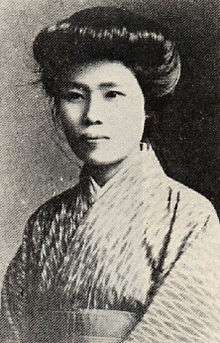Kanno Sugako
| Kanno Sugako | |
|---|---|
 Kanno Sugako |
Kanno Sugako (Japanese: 管野 須賀子), also called Suga (1881–1911),[1] was an anarcho-feminist Japanese journalist by profession. She was the author of a series of articles about gender oppression, and a defender of freedom and equal rights for men and women.
In 1910, she was accused of treason by the Japanese government for her alleged involvement in what became known as the Kotoku incident, aimed at the assassination of Emperor Meiji. She was the first woman with the status of political prisoner to be executed in the history of modern Japan.
Biography
Born in Osaka, she lost her mother at the age of ten. Her father remarried. In addition to being mistreated by her stepmother, Kanno was raped at fifteen. She had her first contact with socialism when reading an essay about the victims of sexual abuse. At seventeen, she married a man belonging to a merchant family in Tokyo in order to escape the mistreatment of her stepmother, only returning to Osaka in 1902.[2]
Kanno began writing in a journal and began to engage in a Christian women's movement against the system of legal brothels. With the start of the Russo-Japanese war, she joined the Socialist-Christian peace movement and in 1906 she became head of a newspaper in the province of Wakayama and began a relationship with the socialist leader Arahata Kanson (1887–1981).
Upon returning to Tokyo, she was involved in an anarchist manifesto whose leaders were arrested in the Red Flag Incident of June 1908. While visiting friends in prison, she was arrested. Upon her release two months later, she met the anarchist Shūsui Kōtoku (1871–1911). Together, they began publishing an anarchist newspaper which was banned by the authorities. Kanno was arrested again.
The High Treason Incident
In her prison diary, Suga notes that she discovered that change could not happen through peaceful channels after the crackdown on the Red Flag Incident, a peaceful protest in 1908 led by left-wing anarchists. It was after she and her comrades were arrested that she came to the conclusion that violent revolution was necessary, so she, her lover, and two other anarchists plotted to assassinate Emperor Meiji. Miyashita Takichi decided to use explosives to kill the Emperor, and the others agreed. After constructing the bomb, the group asked for a comrade, Shimizu Taichiro, to store the bomb, but he turned them over to the police. Along with twenty-three other people (twelve of whose sentences were later commuted to life in prison, and most of whom were not directly involved in the plot), Kanno was sentenced to death and hanged on January 24, 1911. The method of her execution was particularly brutal: "...she was ordered to sit upright on the floor. Two thin cords were placed around her neck. The floor-board was removed. In twelve minutes she was dead."[3]
Legacy
Her life inspired the play Kaiki Shoku (Eclipse), produced by the theater company Aono Jikken Ensemble and written by William Satake Blauvelt.
See also
Bibliography
- ANARKOWIC, Stefan. (1994) Against the god emperor: the anarchist treason trials in Japan. Kate Sharpley Library. 40p.
- CRONIN, Joseph. (2014) The Life of Seinosuke: Dr. Oishi and the High Treason Incident: Second Edition. White Tiger Press.
- Encyclopedia of Modern Asia. 2001-2006 by Macmillan Reference USA, an imprint of the Gale Group.
- HANE, Mikis. (1988) Reflections on the Way to the Gallows: Voices of Japanese Rebel Women. New York: Pantheon.
- Itoya, Toshio. (1970) Kanno Suga. Iwanami Shinsho, 740. 226p.
- RADDEKER, Helene. (1998) Treacherous Women of Imperial Japan: Patriarchal Fictions, Fantasies Patricidal. Routledge.
- SIEVERS, Sharon L. (1983) Flowers in Salt: The Beginnings of Feminist Consciousness in Modern Japan. Stanford: Stanford University Press, 67p.
- SUCKS, Kano at al. (2003) Under the Yoke of the State: Selected Anarchist Responses to Prison and Crime. Kate Sharpley Library. 60p.
- OYA, Wataru. (1989) to Isonokami Tsuyuko Kanno Suga. Osaka. Toho Shuppan.